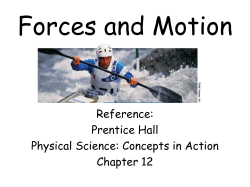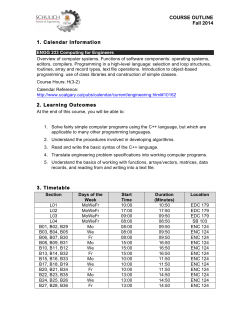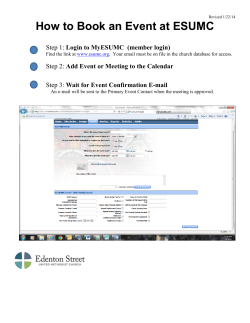
DEPARTMENT OF PHYSICS AND ASTRONOMY COURSE OUTLINE Lecture Sections:
DEPARTMENT OF PHYSICS AND ASTRONOMY COURSE OUTLINE 1. Course: Physics 211, Mechanics Lecture Sections: L01: MTWF 08:00-08:50 ICT102 Dr. Andrew Yau SB624 yau@ucalgary.ca L02: MWF 12:00-12:50 MFH162 Varun Narasimhachar T 11:00-11:50 ST140 L03: MWRF 16:00-16:50 ICT102 Mohammad Khazali Course Coordinator: Course Website: D2L Course Departmental Office: 2. 220-8825 Office: W 10:00-11:00 vnarasim@ucalgary.ca Office: W 11:00-12:00 mkhazali@ucalgary.ca Office: W 12:00-13:00 Dr. Andrew Yau: SB 623 220-8825 yau@ucalgary.ca http://webapps3.ucalgary.ca/~dppvan/phys211-221/ PHYS 211 L01-03/PHYS 221 L01-02 - (Fall 2014) – Mechanics SB 605, 403-220-5385, phasugrd@ucalgary.ca Prerequisites: Pure Mathematics 30 or Mathematics II (offered by Continuing Education) NOTNOTE: Physics 30 is recommended as preparation for Physics 211. Physics 211 is not open to students with 70% or higher in Physics 30 and Pure Mathematics 30 and 60% or higher in Mathematics 31, except with Departmental permission. 3. Grading: The University policy on grading and related matters is described sections F.1 and F.2 of the online University Calendar. In determining the overall grade in the course the following weights will be used: Assignments (12) Laboratory experiments (9) Diagnostic tests (2) Class Response Activity Midterm test Final Examination 24% 18% 1% 2% 25% (October 17, 17:00-20:00) 30% (To be scheduled by the Registrar) Students who receive a weighted mean mark <40% over the term test and the Final Examination should not expect to receive a course grade higher than “D”. Percentage to letter grade conversion scale: > = 95 % A+ > = 75 % B+ > = 85 % A > = 70 % B > = 80 % A> = 65 % B- > = 60 % > = 55 % > = 50 % C+ C C- > = 48 % > = 45 % < 45 % D+ D F 4. Missed Components of Term Work: The regulations of the Faculty of Science pertaining to this matter are found in the Faculty of Science area of the Calendar in Section 3.6. It is the student's responsibility to familiarize himself/herself with these regulations. See also Section E.6 of the University Calendar 5. Scheduled out-of-class activities: Friday 10/17/2014, 17:00-20:00: Mid-term Test REGULARLY SCHEDULED CLASSES HAVE PRECEDENCE OVER ANY OUT-OF-CLASS-TIME-ACTIVITY. If you have a clash with this out-of-class-time-activity, please inform your instructor as soon as possible so that alternative arrangements may be made for you. 6. Course Materials: R.D. Knight, Physics for Scientists and Engineers: A Strategic Approach, 3rd Edition, Addison-Wesley. 7. Examination Policy: Closed book exam and mid-term test with formula sheet provided; calculator allowed; Students should also read the Calendar, Section G, on Examinations. 8. Approved Mandatory and Optional Course Supplemental Fees: None 9. Writing across the curriculum statement: In this course, the quality of the student’s writing in laboratory reports will be a factor in the evaluation of those reports. See also Section E.2 of the University Calendar. 10. Human studies statement: Students in this course are not expected to participate as subjects or researchers. See also Section E.5 of the University Calendar. 11. OTHER IMPORTANT INFORMATION FOR STUDENTS: (a) Academic Misconduct: (cheating, plagiarism, or any other form) is a very serious offence that will be dealt with rigorously in all cases. A single offence may lead to disciplinary probation or suspension or expulsion. The Faculty of Science follows a zero tolerance policy regarding dishonesty. Please read the sections of the University Calendar under Section K. Student Misconduct to inform yourself of definitions, processes and penalties (b) Assembly Points: In case of emergency during class time, be sure to FAMILIARIZE YOURSELF with the information on assembly points. (c) Academic Accommodation Policy: Students with documentable disabilities are referred to the following links: Calendar entry on students with disabilities and Student Accessibility Services. (d) Safewalk: Campus Security will escort individuals day or night (http://www.ucalgary.ca/security/safewalk/). Call 220-5333 for assistance. Use any campus phone, emergency phone or the yellow phones located at most parking lot pay booths. (e) Freedom of Information and Privacy: This course is conducted in accordance with the Freedom of Information and Protection of Privacy Act (FOIPP). As one consequence, students should identify themselves on all written work by placing their name on the front page and their ID number on each subsequent page. For more information see also (f) http://www.ucalgary.ca/secretariat/privacy. (g) Student Union Information: VP Academic Phone: 220-3911 Email: suvpaca@ucagary.ca. SU Faculty Rep. Phone: 220-3913 Email: sciencerep@su.ucalgary.ca; Student Ombudsman (h) Internet and Electronic Device Information: You can assume that in all classes that you attend, your cell phone should be turned off unless instructed otherwise. Also, communication with other individuals, via laptop computers, Blackberries or other devices connectable to the Internet is not allowed in class time unless specifically permitted by the instructor. If you violate this policy you may be asked to leave the classroom. Repeated abuse may result in a charge of misconduct. (i) At the University of Calgary, feedback provided by students through the Universal Student Ratings of Instruction (USRI) survey provides valuable information to help with evaluating instruction, enhancing learning and teaching, and selecting courses (www.ucalgary.ca/usri). Your responses make a difference - please participate in USRI Surveys. Lecture outline 1 2 3 4 5 6 7 8 9 Motion diagrams; Particle model; Position and Time; Velocity Linear Acceleration; Motion in One Dimension; Solving Problems in Physics; Units and significant figures, Uniform motion; Instantaneous velocity Finding position from velocity; Motion with constant acceleration; Free fall; Motion on an inclined plane; Instantaneous acceleration; Vectors; Properties of vectors; Coordinate systems and vector components Vector algebra; Acceleration; Kinematics in two dimensions; Projectile Motion; Uniform circular motion Uniform circular motion; Velocity and acceleration in uniform circular motion; Non-uniform circular motion; Force; A short catalog of forces; Identifying forces; What do forces do; Newton's Second Law; Newton's First Law; Free-Body Diagrams; Equilibrium; Using Newton's Second Law Mass, weight, and gravity; Friction; Drag; More examples of Newton's Second Law; Interacting Objects; Analyzing Interacting Objects Newton's Third Law; Ropes and pulleys; Examples of interacting-object problems; Dynamics in two dimensions; Uniform circular motion; Circular orbits; Non-uniform circular motion 10 11 12 13 Momentum and Impulse; Solving impulse and momentum problems; Conservation of momentum; Inelastic collisions; Explosions; Momentum in Two Dimensions The basic energy model; Kinetic energy and gravitational potential energy; A closer look at gravitational potential energy; Restoring forces and Hooke's Law; Elastic potential energy; Elastic collisions; Energy diagrams; Basic energy model revisited; Work and kinetic energy Calculating and using work; Work done by a variable force; Work and potential energy; Thermal energy; Conservation of energy; Power Lab outline 1 2 3 4 5 6 7 8 9 Units, equipment, motion diagrams Measuring motion Motion on the Inclined plane Two-dimensional motion Statics (Newton's 1st Law in 2D) Newton's Second Law Newton's Third Law Collisions in One Dimension Conservation of energy and Simple Harmonic Oscillators (SHO) Department Approval____________________________________________Date__________________________ Associate Dean’s Approval for out of regular class-time activity: ___________________________________Date:_________________________
© Copyright 2025





















